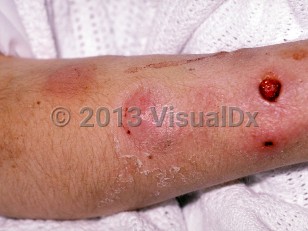Skin bacterial abscess in Adult
See also in: Cellulitis DDx,Anogenital,Hair and ScalpAlerts and Notices
Important News & Links
Synopsis

An abscess is a localized inflammatory process in which the white blood cells accumulate at the site of infection in the dermis and/or subcutaneous tissue, creating a collection of pus. Commonly associated pathogens are Staphylococcus aureus, streptococci, and normal skin flora. Trauma or any break in the skin barrier predisposes to abscess formation.
Lesions evolve over days to 1-2 weeks. They are usually painful / tender, erythematous, warm, and fluctuant masses that are sometimes associated with fever. A tender subcutaneous nodule with overlying erythema but minimal fluctuance may be an early presentation. Incision and drainage is the mainstay of therapy. In an otherwise healthy, ambulatory patient, the addition of antibiotics is not indicated. Indications for the addition of antibiotics may include patients who are systemically ill, have a high burden of disease (indicated by concomitant widespread folliculitis or associated cellulitis), are immunosuppressed, or have failed incision and drainage.
Methicillin-resistant S. aureus (MRSA) first emerged as an important nosocomial pathogen in the 1960s. In more recent years, community-acquired outbreaks of MRSA (CA-MRSA) have increasingly been described among healthy individuals lacking the traditional risk factors for such infections (intravenous [IV] drug use, incarceration, participation in contact sports, etc). These strains have a propensity for causing abscesses, furunculosis, and folliculitis and have a unique antibiotic susceptibility profile from health care-associated strains of MRSA (HA-MRSA).
It has been shown that the majority of purulent skin and soft tissue infections presenting to emergency rooms across the United States are caused by CA-MRSA.
Lesions evolve over days to 1-2 weeks. They are usually painful / tender, erythematous, warm, and fluctuant masses that are sometimes associated with fever. A tender subcutaneous nodule with overlying erythema but minimal fluctuance may be an early presentation. Incision and drainage is the mainstay of therapy. In an otherwise healthy, ambulatory patient, the addition of antibiotics is not indicated. Indications for the addition of antibiotics may include patients who are systemically ill, have a high burden of disease (indicated by concomitant widespread folliculitis or associated cellulitis), are immunosuppressed, or have failed incision and drainage.
Methicillin-resistant S. aureus (MRSA) first emerged as an important nosocomial pathogen in the 1960s. In more recent years, community-acquired outbreaks of MRSA (CA-MRSA) have increasingly been described among healthy individuals lacking the traditional risk factors for such infections (intravenous [IV] drug use, incarceration, participation in contact sports, etc). These strains have a propensity for causing abscesses, furunculosis, and folliculitis and have a unique antibiotic susceptibility profile from health care-associated strains of MRSA (HA-MRSA).
It has been shown that the majority of purulent skin and soft tissue infections presenting to emergency rooms across the United States are caused by CA-MRSA.
Codes
ICD10CM:
L02.91 – Cutaneous abscess, unspecified
SNOMEDCT:
31928004 – Abscess of skin AND/OR subcutaneous tissue
L02.91 – Cutaneous abscess, unspecified
SNOMEDCT:
31928004 – Abscess of skin AND/OR subcutaneous tissue
Look For
Subscription Required
Diagnostic Pearls
Subscription Required
Differential Diagnosis & Pitfalls

To perform a comparison, select diagnoses from the classic differential
Subscription Required
Best Tests
Subscription Required
Management Pearls
Subscription Required
Therapy
Subscription Required
References
Subscription Required
Last Updated:10/08/2017
 Patient Information for Skin bacterial abscess in Adult
Patient Information for Skin bacterial abscess in Adult
Premium Feature
VisualDx Patient Handouts
Available in the Elite package
- Improve treatment compliance
- Reduce after-hours questions
- Increase patient engagement and satisfaction
- Written in clear, easy-to-understand language. No confusing jargon.
- Available in English and Spanish
- Print out or email directly to your patient
Upgrade Today

Skin bacterial abscess in Adult
See also in: Cellulitis DDx,Anogenital,Hair and Scalp

